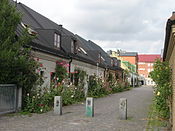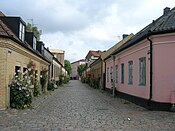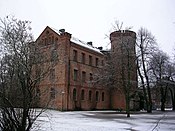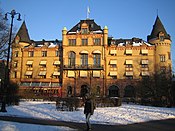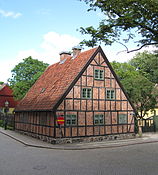Lund
You can help expand this article with text translated from the corresponding article in Swedish. (February 2016) Click [show] for important translation instructions.
|
Lund | |
|---|---|
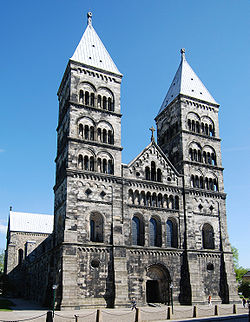 Lund Cathedral | |
| Motto: Idéernas stad (Eng: The city of ideas) | |
| Country | Sweden |
| Province | Scania |
| County | Skåne County |
| Municipality | Lund Municipality |
| Area | |
| • Total | 25.75 km2 (9.94 sq mi) |
| Population (31 December 2010)[1] | |
| • Total | 82,800 |
| • Density | 3,215/km2 (8,330/sq mi) |
| Time zone | UTC+1 (CET) |
| • Summer (DST) | UTC+2 (CEST) |
| Website | www |
Lund (Swedish pronunciation: [lɵnd] ) is a city in the province of Scania (Skåne), southern Sweden. The town has 87,244 inhabitants in 2010,[2] out of a municipal total of 116,883.[3] It is the seat of Lund Municipality, Skåne County. The city is believed to have been founded around 990, when Scania belonged to Denmark. It soon became a major Christian centre of the Baltic Sea region, at a time when the area was still a frontier area for Christian mission, and within Scandinavia and especially Denmark through the Middle Ages. From 1103 it was the see of the Catholic Metropolitan Archdiocese of Lund. At the centre of the city stands the towering Lund Cathedral, built circa 1090–1145.
Lund University, established 1666, is today one of Scandinavia's largest institutions for education and research.[4][5][6]
History
Along with Sigtuna, Lund is the oldest city in present-day Sweden. Lund's origins are unclear. Until the 1980s, the town was thought to have been founded around 1020 by either Sweyn I Forkbeard or his son Canute the Great of Denmark.[7] The area was then part of the kingdom of Denmark. But, recent archaeological discoveries suggest that the first settlement dated to circa 990, possibly the relocation of settlers at Uppåkra. The Uppåkra settlement dates back to the first century B.C.[8] and its remains are at the present site of the village of Uppåkra. King Sweyn I Forkbeard moved Lund to its present location, a distance of some five kilometres (3.1 miles). The new location of Lund, on a hill and across a ford, gave the new site considerable defensive advantages in comparison with Uppåkra, situated on the highest point of a large plain.
The city was made a see in 1048 and united with Dalby in 1060,[9] and in 1103 became the see of the Metropolitan Archdiocese of Lund, whose ecclesiastical province comprised Scandinavia and even Garðar on Greenland. The diocese of nearby Dalby was absorbed in 1066. Lund Cathedral was similarly founded in or shortly after 1103. In 1152, the Norwegian archdiocese of Nidaros was founded as a separate province of the church, independent of Lund. In 1164 Sweden also acquired an archbishop of its own, although he was nominally subordinate to the archbishop of Lund. It is still, as the diocese of Lund, a diocese in the Church of Sweden.

Lund Cathedral School (Katedralskolan) was founded in 1085 by the Danish king Canute the Saint. This is the oldest school in Scandinavia and one of the oldest in Northern Europe. Many prominent people were educated there, among them the actor Max von Sydow and several high-ranking politicians.
In 1658, the Scanian lands were ceded by Denmark to Sweden by the Treaty of Roskilde. On December 4, 1676 Lund was defended in the Battle of Lund, one of the bloodiest battles fought in Scandinavia.
Lund University, established in 1666, is Sweden's largest, with 42,000 full or part-time students, although not all live in Lund. The figure includes Lund Institute of Technology, which is to some extent independent of the old university. As late as the 1940s, Lund was a relatively small city with few large-scale industries, covering only about a quarter of the current urban area, and dominated by the cathedral and the university. [citation needed] Since then, the student population has increased about twelvefold; many industrial companies in the chemical, medical or electronics branches and, from the 1990s within information management, have set up establishments in the city; and the town's population, architecture and energy have been transformed.
Charles XII of Sweden resided in the city between 1716-1718, making Lund the temporary capital of Sweden during that time.
Compared with many other Swedish cities, the urban heart of Lund is well preserved. A local law requires archaeological excavation in association with any properties in the city centre which are scheduled for demolition and redevelopment.
In 1943, during the Second World War Lund was accidentally bombed by British bomber aircraft's. No person were reported killed, though some people were injured by glass fragments. The cause of the bombings has been debated, though the general thought is that the real target was Stettin. Some debate that it was intentional. Lund together with some other Swedish cities were bombed, in 1944 Stockholm and Strängnäs was bombed by Soviet aircraft, here the general thought is that the bombing was intentional and determined by the allies.
Geography
Lund is located in Sweden's largest agricultural district, in the south-west of Scania, less than ten kilometres (6.2 miles) from the sandy shore of the Öresund Strait. From the top of the Sankt Hans Hill it is possible to see Copenhagen, the capital of Denmark. It is therefore some distance from other Swedish cities, about 250 kilometres (160 miles) to Gothenburg, 600 kilometres (370 miles) to Stockholm and about 1,200 kilometres (750 miles) to Umeå. The city of Malmö, on the other hand, is only about 15 kilometres (9.3 miles) away.
Climate
Lund, like the rest of southern Sweden, has an oceanic climate. Despite its northerly location, the climate is relatively mild compared to other locations in similar latitude, or even somewhat further south, mainly because of its proximity to the sea. Because of its northerly latitude, daylight lasts as long as 17 hours in midsummer, and only around 7 hours in mid-winter.
Summers are warm and pleasant with average high temperatures of 23 °C (73 °F) and lows of around 14 °C (57 °F), but temperatures do sometimes exceed 25 °C (77 °F) and occasional heat waves are common during the summer. Winters are cold, with temperatures steady between −1 to 3 °C (30 to 37 °F). It has arguably the mildest climate of the country in average highs. In terms of yearly means Falsterbo is marginally milder to extremely mild lows.
Rainfall is light to moderate throughout the year with 169 wet days. Snowfall occurs sparingly, mainly from December to March, but snow cover does not remain for a long time, and some winters tend to be virtually free of snow.
| Climate data for Lund 2002-2015; precipitation 1961-1990; extremes since 1901 | |||||||||||||
|---|---|---|---|---|---|---|---|---|---|---|---|---|---|
| Month | Jan | Feb | Mar | Apr | May | Jun | Jul | Aug | Sep | Oct | Nov | Dec | Year |
| Record high °C (°F) | 10.9 (51.6) |
14.0 (57.2) |
19.3 (66.7) |
27.1 (80.8) |
29.0 (84.2) |
33.9 (93.0) |
34.3 (93.7) |
33.8 (92.8) |
27.6 (81.7) |
22.4 (72.3) |
16.1 (61.0) |
12.0 (53.6) |
34.3 (93.7) |
| Mean daily maximum °C (°F) | 2.5 (36.5) |
2.9 (37.2) |
7.1 (44.8) |
13.3 (55.9) |
17.7 (63.9) |
20.6 (69.1) |
23.8 (74.8) |
22.7 (72.9) |
18.6 (65.5) |
12.6 (54.7) |
7.8 (46.0) |
4.2 (39.6) |
12.8 (55.0) |
| Daily mean °C (°F) | 0.4 (32.7) |
0.6 (33.1) |
3.4 (38.1) |
6.9 (44.4) |
12.7 (54.9) |
15.9 (60.6) |
18.8 (65.8) |
18.3 (64.9) |
14.5 (58.1) |
9.4 (48.9) |
5.6 (42.1) |
2.1 (35.8) |
9.0 (48.2) |
| Mean daily minimum °C (°F) | −1.6 (29.1) |
−1.6 (29.1) |
−0.2 (31.6) |
3.6 (38.5) |
7.8 (46.0) |
11.1 (52.0) |
13.9 (57.0) |
13.8 (56.8) |
10.4 (50.7) |
6.1 (43.0) |
3.4 (38.1) |
0.1 (32.2) |
5.5 (41.9) |
| Record low °C (°F) | −26.3 (−15.3) |
−21.7 (−7.1) |
−17.2 (1.0) |
−8.9 (16.0) |
−3.9 (25.0) |
2.0 (35.6) |
5.0 (41.0) |
5.0 (41.0) |
0.0 (32.0) |
−8.5 (16.7) |
−12.0 (10.4) |
−19.4 (−2.9) |
−26.3 (−15.3) |
| Average precipitation mm (inches) | 54.4 (2.14) |
33.1 (1.30) |
45.0 (1.77) |
40.3 (1.59) |
44.5 (1.75) |
55.5 (2.19) |
69.7 (2.74) |
64.6 (2.54) |
64.2 (2.53) |
60.4 (2.38) |
68.9 (2.71) |
65.3 (2.57) |
665.8 (26.21) |
| Mean monthly sunshine hours | 45 | 63 | 156 | 226 | 245 | 245 | 251 | 212 | 173 | 112 | 45 | 28 | 1,801 |
| Source 1: SMHI Average Precipitation 1961-1990[10] | |||||||||||||
| Source 2: SMHI Average Data 2002-2015[11] | |||||||||||||
Culture

The culture in Lund is characterised by the university education and research, and the large student population and student traditions, such as a student theatre group since 1886.[12] A substantial part of the student night-life is located at student fraternities called 'Nations'.
Lund Cathedral, the Lutheran cathedral in Lund, is the seat of the bishop of Lund of the Church of Sweden. Lund also has a city theatre (though without a professional local ensemble of its own) and a number of other places for concerts and theatres.
Lund hosts the largest open-air museum of Scania, Kulturen. Kulturen is the second oldest dedicated open-air museum in the world and consists of more than 30 buildings, as well as large collections on Scanian art, crafts. local archaeology and history. The museum was founded in 1892 by Georg Karlin. Today the museum often hosts different exhibitions and its visitors can experience how Swedish people lived and worked throughout the centuries.[13]
Literature, art, and cinema

Numerous prominent figures from the literary world lived and worked in Lund, often in association with the university and theatre. They are listed below with notable natives.
The city has a vivid tradition in music and theatre, stimulated by the church, university, schools, student musical festivities, and the Spex tradition (parodistic musical plays, often setting well-known music to new lyrics and mixing up the historical and the present in unconventional intrigues) and, especially, the "Lund Carnival" (for which see the special section).
Lund has long been a regional centre for classical and church music. In particular, Lund is renowned for its vibrant amateur choir scene, with choirs such as Carolinae damkör, Domkyrkokören, Katedralkören, Lunds akademiska kör, Lund Chamber Choir (Swedish: Lunds Kammarkör), Lunds Studentsångförening, Lunds vokalensemble, and the Svanholm Singers. Since 2006, Lund has been the host of the biannual Lund International Choral Festival.[14] In more recent decades, Lund has also developed a lively pop and jazz scene.
The concluding scenes in Ingmar Bergman's classic film Wild Strawberries were set in, and were shot in, Lund.
With its International Architecture Film Festival in Lund, since 2009, Lund is a centre in Øresund for architecture and film.
Lundakarnevalen

The Lund carnival has been held every four years since the mid-nineteenth century: traditional accounts say it originated at a wedding in 1849 (the four-year intervals place the party in 2002, 2006, 2010, etc.). Arranged by the students of the university, from the 1950s onwards the event has grown in size and intensity (with some 5500 volunteers 2010), but it remains an amateur event. Midway between a music and stage fair, a city festival, and an outpouring of satire, parody and general madness. Some students dress up in costumes, often relating to and poking fun at current issues, and parade in wagons. Others perform humorous skits in the evenings. The carnival revues and other stage entertainments have launched a number of well-known entertainers and actors over the years.
Education
- Lund University
- Lund Institute of Technology
- Lund School of Economics and Management
- Royal Swedish Physiographic Society
- Ljud & Bildskolan
Sports
Lund is not a notable centre for sports except for handball, where it has two teams in the men's top league: H 43 and LUGI and two teams in the women's top league: H43/Lundagård and LUGI. Lund hosted matches from the 2011 Handball World Championship in the Färs och Frosta Sparbank Arena.
It also has a chess team, Lunds ASK, that for decades has been among the top teams in Sweden.
Lund is also the birthplace of the online football manager game Hattrick. Lund also has a Division 1 football club called Lunds BK. In Lund you will also find Lugi Rugbyklubb, one of Sweden's few rugby clubs.
Transport

Major roads
Lund has been connected to the motorway network since 1953 when the E22, the first motorway in Sweden, was built round the edge of the town. There are also other connections to most major roads in the area, for example the E6 via Riksväg 16, and the Länsväg 108 which connects to the E65.

Cycling
Lund has been praised for its cycling infrastructure.[15] There are 5,000 bike parking spaces in the town, including a multi-storey facility, 160 km (99 mi) of cyclepaths, and 45% of commuters travel by bicycle. There has been no increase in car usage for the past 10 years.
Railways and public transport
Lund has been on the main railway line between Malmö and Stockholm since 1857. Today there are direct connections to Copenhagen and Helsingør via the Öresund Bridge. This connection is mainly served by the Öresundståg, maintained by DSB, the Danske Statsbaner in Denmark and Skånetrafiken in Scania, as well as by SJ in the rest of Sweden. Local traffic is managed by the two-coach electric multiple units Pågatåg, which provide connections to many destinations in Scania. Because of Lund's central position, it is possible to travel to the three largest cities in Sweden without having to change trains.
Public transport within Lund is overseen by Skånetrafiken[16] but the actual bus network is licensed to the Nettbuss Stadsbussarna company. The city buses connect around 120 bus stops with 9 bus lines served by a fleet of 48 MAN and Mercedes-Benz Citaro[citation needed] running on compressed natural gas. The Mercedes buses were taken out of service in 2013 when "Netbuss Stadsbussarna" took over, but have made a short comeback due to an increased number of departures in the new timetable. More MAN buses have been ordered and are expected to be delivered in October. There are plans to initiate a tram network[17] to achieve faster and higher-capacity public transport between Lund Central Station and many of the largest work-places in the city. Including the hospital, university and in the future European Spallation Source. There are also plans to extend this network to the suburban towns of Dalby, Staffanstorp and Södra Sandby, but these are far into the future.
In recent years the pressure on rail and bus lines has increased, due to the ever-growing commuting between Lund, Malmö and other nearby places and increased casual and professional contacts with the Copenhagen area. As of 2009[update], the railyard and quays area of Lund station is undergoing some rearrangements to accommodate expected growth in traffic, while Malmö Central railway station has also been rebuilt in tandem with the Malmö City Tunnel, which opened in December 2010.
Airports
Lund is located close to Malmö-Sturup Airport which is mainly used for domestic flights. Kastrup, the airport for Copenhagen is often used for longer international flights, and is about 33 minutes by train from Lund. There also used to be a very small airstrip, Hasslanda Flygfält, to the south of Lund, mainly used for private and charter flights. The airstrip closed in 2008.
Industry
Lund is a centre of high tech companies, such as Sony Mobile Communications, Ericsson, Doro, Microsoft and other telecommunication companies. The Lund Institute of Technology has historical connections with the industrial economy. A business park, Ideon Science Park, is for high tech companies that have ties to the university.
Other important industries include medical technology (Gambro), pharmaceuticals, biotechnology (Active Biotech, among others), heat exchanger and separator (Alfa Laval), and publishing and library services. The hospital and the university in Lund are two other major employers, with extensive research facilities.
Astra Zeneca offices closed down in 2010 and has been replaced by research park of Medicon Village.[18]
Lund is home to the Tetra Pak company, which manufactures and markets paper packaging and equipment for milk, orange juice, etc. all over the world.
Main sights
During the 12th and 13th centuries, when the town was the seat of the archbishop, many churches and monasteries were built. At its peak, Lund had 27 churches, but most of them were demolished as result of the Reformation in 1536. Several medieval buildings remain, including Lund Cathedral, Liberiet, the restaurant Stäket and parts of the Cathedral School.

Most of the central buildings in Lund date from the late 19th century, when small houses were replaced by multi-storey ones. Notable buildings built during this period include the University Library (1902), Grand Hotel (1899) and the University Main Building (1882).
- Lund
-
Hjortgatan (Deer Street)
-
Korsgatan (Cross Street)
-
Lund-SL
-
Mariagatan (Maria Street)
-
The Clemens place
-
Lunds centralstation
-
Palaestra
-
Kungshuset
-
The Old library
-
The Old Bull Pub
-
University library
-
Akademiet i Lund
-
Doktorspromovering, a solemn graduation ceremony when tradition crave shouting with canons
-
Locus Peccatorum, early 18th century, corner of Adelgatan (Nobility street) and Sankt Annegatan (St Anne street)
-
This picture depicts the old lilacs before they were cut down
-
Östervång school
-
The open-air museum Kulturen, a collection of historical buildings
Notable natives and residents
- Klas Anshelm, architect
- Axwell, professional DJ
- Rolf-Göran Bengtsson, Olympic equestrian
- Martin Dahlin, footballer
- Timbuktu (Jason Diakité), hip-hop and reggae artist
- Kim Ekdahl du Rietz, handball player
- Joel Ekstrand, footballer
- Olle Hagnell, psychiatrist and professor
- Mikael Håfström, film writer and director
- Anders Jansson, comedian
- Amanda Jenssen, singer
- Joachim Johansson, tennis player
- Helena Josefsson, singer
- Roger Ljung, footballer
- Jan Malmsjö, actor
- Lukas Moodysson, film writer, director
- Ivo Pekalski, footballer
- The Radio Dept., band
- Ola Svensson, pop singer
- Max von Sydow, actor
- Linus Thörnblad, Olympic high jumper
- Johan Wester, comedian
- Elin Wägner, feminist writer
- Måns Zelmerlöw, pop singer and winner of Eurovision Song Contest 2015.
Literary residents
- Vilhelm Ekelund, poet
- Hjalmar Gullberg, writer, poet and translator
- Britt G. Hallqvist, writer, poet and translator
- Ola Hansson, writer, poet and critic
- Carl Linnaeus, scientist and author
- Axel Lundegård, writer
- Anders Österling, writer, poet, translator and critic
- Lars Norén, poet and playwright
- Bengt Lidforss, natural scientist and writer
- Göran Sonnevi, poet and translator
- August Strindberg, playwright
- Esaias Tegnér, writer and bishop
International relations
Twin towns — sister cities
Lund is twinned with the following cities:[19]
|
In Nordic countries: |
Rest of the world:
|
See also
- Lund Principle, an important principle in ecumenical relations between Christian churches.
- Uppsala
References
- ^ a b "Localities 2010, area, population and density in localities 2005 and 2010 and change in area and population". Statistics Sweden. 29 May 2012. Archived from the original on 17 December 2012.
{{cite web}}: Unknown parameter|deadurl=ignored (|url-status=suggested) (help) - ^ http://www.statistikdatabasen.scb.se/pxweb/sv/ssd/START__MI__MI0810__MI0810A/LandarealTatort
- ^ http://www.scb.se/sv_/Hitta-statistik/Statistik-efter-amne/Befolkning/Befolkningens-sammansattning/Befolkningsstatistik/25788/25795/Kvartals--och-halvarsstatistik---Kommun-lan-och-riket/407449/
- ^ Lund University, The Solander Program Website
- ^ Universities in the Øresund Region, Øresund Entrepreneurship Academy Website
- ^ "Start - Lunds universitet".
- ^ Cohen, Sidney (1977). "The Earliest Scandinavian Towns". The Medieval City. New Haven, CT: Yale University Press: 313–325.
{{cite journal}}:|access-date=requires|url=(help) - ^ "Uppåkra - en forntida centralort". Retrieved 23 May 2010.
- ^ Herbermann, Charles, ed. (1913). . Catholic Encyclopedia. New York: Robert Appleton Company.
- ^ "Precipitation Averages 1961-90". SMHI. April 2015. Retrieved 21 April 2015.
- ^ "Statistics from Weather Stations (Swedish)". SMHI. March 2016. Retrieved 18 March 2016.
- ^ Lundaspexarna. "Lundaspexarna".
- ^ Välkommen till Kulturen i Lund - startsida Archived May 9, 2008, at the Wayback Machine
- ^ "Lund Choral Festival". Lund Choral Festival.
- ^ "The city where bicycles dominate". BBC News. 2009-12-03.
- ^ Åk grönt med Skånetrafikens stadsbussar, (in Swedish) Retrieved July 24, 2010.
- ^ "Spårväg Lund". sparvaglund.se. Retrieved 2014-02-22.
- ^ "Medicon Village". Medicon Village.
- ^ "The sister cities of Lund" (in Swedish). Lund municipality. Retrieved 11 February 2015.
External links
- Lunds Kommun - Official site
- Visitlund.se Tourist information
- . New International Encyclopedia. 1905.
- . Encyclopædia Britannica (11th ed.). 1911.




